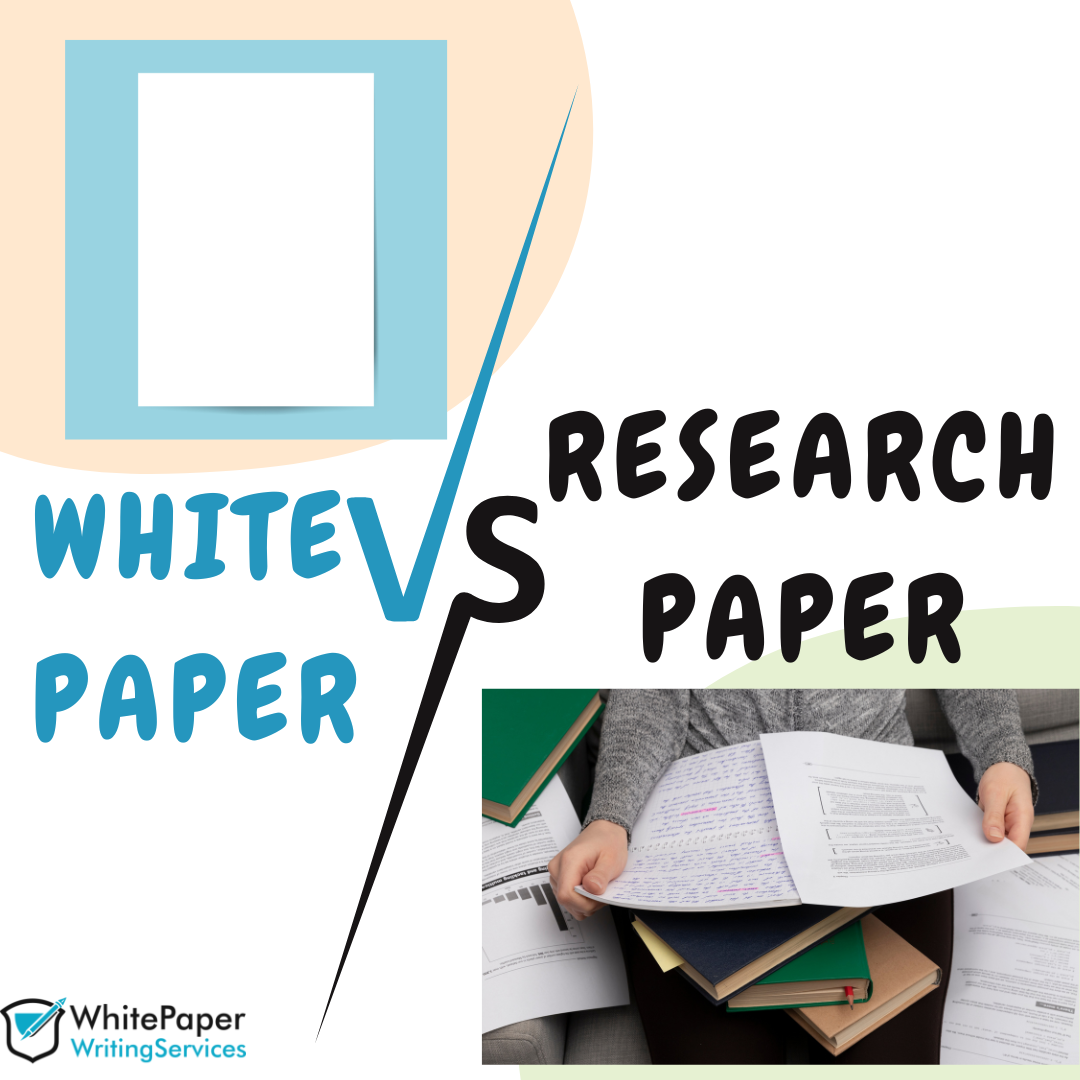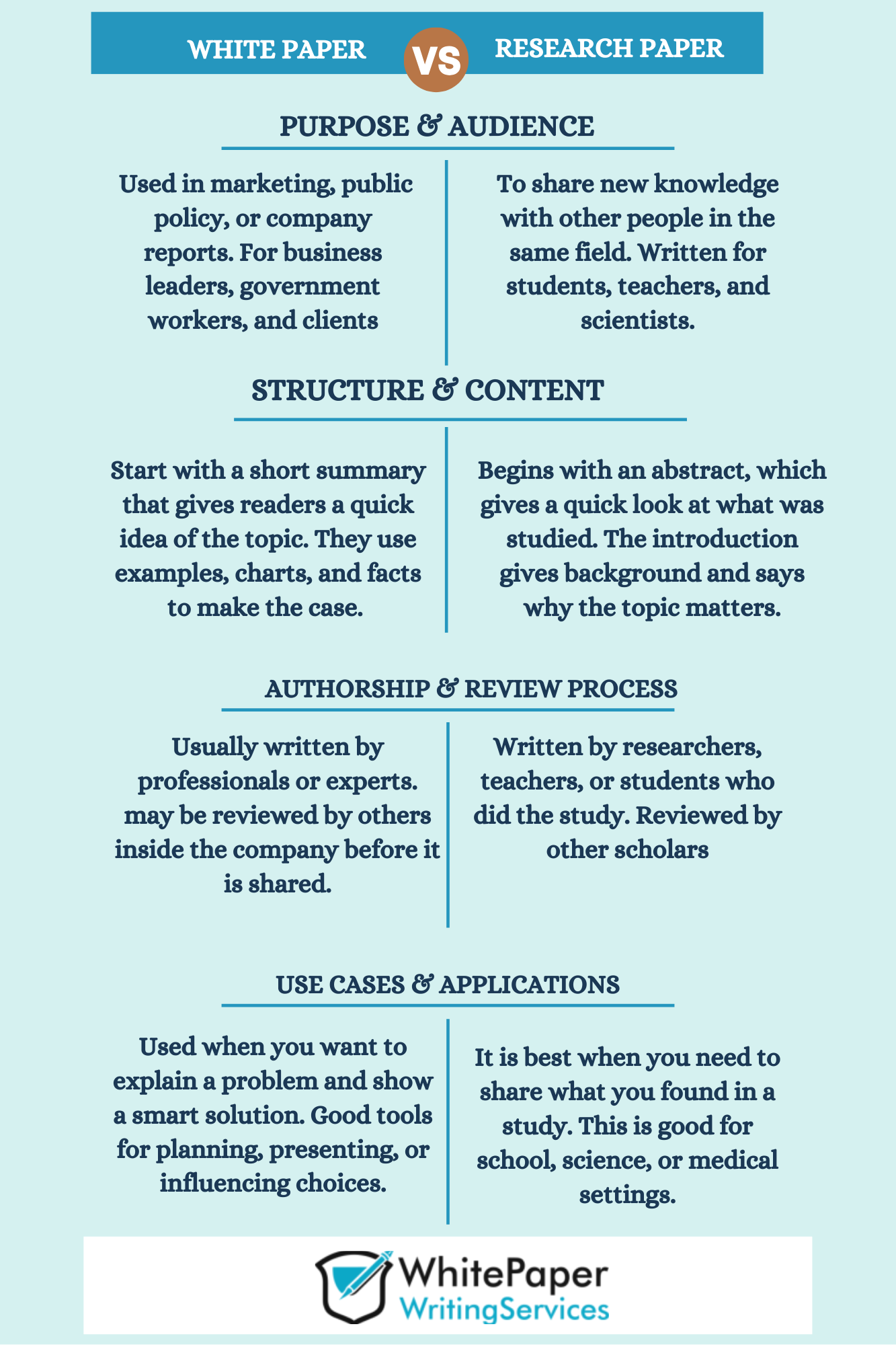White Paper vs. Research Paper: Understanding the Key Differences
April 22, 2025 · 9 min read

White papers and research papers are both written to share information, but they are used in very different ways. A white paper is used more often in business or public services to explain a problem and show a solution. It helps readers understand why the topic matters and what can be done about it.
A research paper, on the other hand, is usually used in schools and science. It shows what was studied, how it was studied, and what was found. These papers follow strict rules and are meant to add to academic knowledge. Knowing how these papers are different helps you decide which one is right for your work.
In this article, you’ll learn how each paper works, who uses them, and how they are written. This will help you choose the best format for your project or audience.
Defining White Papers and Research Papers
Before we dive deeper, it’s important to define what each paper is. A white paper is a long document that explains a problem and gives a smart way to fix it. These papers are written by professionals to show they understand the issue and know what to do about it.
A research paper is more formal and is based on study or experiment. It follows a strict format and is written by students or researchers. The purpose is to add new knowledge to the field and share results that others can build on.
White papers use real-world examples and data to make a case. Research papers use tests, methods, and results. Both types are important, but they are used in different ways and for different groups of people.
What Is a White Paper?
A white paper explains a complex issue in a way that helps people make a decision. It uses facts, examples, and charts to make the topic easy to understand. Businesses use white papers to explain how their services solve a problem.
The goal is to build trust with the reader and show that the writer knows the topic well. It’s not meant to sell something directly, but it does show value. Most white papers are written in a clear tone with helpful headings. They are designed to be read by busy professionals who want useful information quickly.
What Is a Research Paper?
A research paper is a document that shares what a person or team learned from studying a topic. It includes where the idea came from, how the study was done, and what the results were. The paper is checked by other experts before it is published to make sure it is accurate.
It follows a set structure that includes an abstract, introduction, method, results, and conclusion. Research papers are mostly written by students, scientists, or teachers. The language is more formal and is aimed at people who understand the subject deeply. These papers help add to what we know about a topic and often lead to more studies later.
Differences Between White Papers and Research Papers:
White papers and research papers both serve to inform readers, but they do so in different ways. A white paper is used to explain problems and present solutions, often in a business or industry setting. A research paper is focused on sharing findings from a formal study or investigation. Understanding how they differ helps you choose the right approach for your goal and audience. The following section breaks down their main differences in purpose, tone, structure, and use. The following are the differences between a white paper and a research paper.
White Paper Vs. Research Paper

Purpose and Audience
White papers and research papers have very different goals and are written for different people. Understanding this helps you write better and reach the right audience. While both papers use data, how they use it is not the same.
The audience expects different things depending on the type of paper. In this section, we’ll look at why each paper is written and who reads it. Knowing this will help you plan your content more clearly.
Purpose of a White Paper
The purpose of a white paper is to explain a topic and offer a helpful solution. It gives readers the background they need to make a smart choice. White papers are often used in marketing, public policy, or company reports.
White papers are written to help the reader understand and decide, not just to inform. They are useful tools for explaining why a solution is the right one. White papers build trust by showing facts in a useful and clear way.
Purpose of a Research Paper
The goal of a research paper is to share new knowledge with other people in the same field. It is written to add to what we already know, not to explain or sell something. These papers follow a set format so others can study the same topic later.
Research papers are often graded, published, or used in future studies. The reader expects the work to be serious, careful, and based on facts. That’s why the language is more formal and exact.
Target Audience Differences
White papers are written for people who want to understand and take action. This includes business leaders, government workers, and clients. The tone is clear and simple, and the paper avoids too many hard terms.
Research papers are written for students, teachers, and scientists. They expect deep details and formal words. This difference changes how each paper is written and shared.
Structure and Content
How a paper is built matters a lot. Both white papers and research papers follow a structure. This helps readers know where to look for answers and makes the paper easier to follow. While both include facts and examples, the way they organize them is very different.
White papers focus on solutions and actions. Research papers follow steps to prove something. This section explains how each type is put together from beginning to end.
Structure of a White Paper
White papers often start with a short summary that gives readers a quick idea of the topic. Next, they explain the problem and give background information. After that, they offer a solution and explain why it works. They use examples, charts, and facts to make the case.
The paper ends with a strong conclusion that repeats the main message. It may also have tips, action steps, or a call to reach out for more help.
Structure of a Research Paper
A research paper begins with an abstract, which gives a quick look at what was studied. The introduction gives background and says why the topic matters. Then the methods section explains how the study was done.
The results section shares what was found. The paper ends with a discussion and conclusion, which explains what the results mean. At the end, a long list of sources is included.
Authorship and Review Process
Who writes a paper and how it is reviewed matters to the reader. It can show how serious the paper is and how much care went into making it. This is one of the biggest differences between white papers and research papers. Let’s look at how authorship and review work in both types.
Authorship in White Papers
White papers are usually written by professionals or experts. These writers often work in the company or field they are writing about. They use real-world experience, data, and research to build their case.
Sometimes the writer’s name is not listed because it’s the company that takes credit. The paper may be reviewed by others inside the company before it is shared. This makes sure it fits the brand and purpose.
Authorship in Research Papers
Research papers are written by researchers, teachers, or students who did the study. They often work in schools, hospitals, or labs.
All the people who helped with the research are listed as authors. This shows who did the work and who is responsible for the findings. It also helps readers check the background of the authors.
Review and Publication
White papers are reviewed by people inside a company or team. The goal is to make sure the paper makes sense and fits the goal.
Research papers go through peer review. That means other experts read the paper before it gets published. They check the facts, methods, and ideas. This step helps keep research honest and strong.
Use Cases and Applications
White papers and research papers are used in different ways. Knowing when to use each one helps you get better results. In this section, you’ll learn where these papers are used and what they are best for.
When to Use a White Paper
Use a white paper when you want to explain a problem and show a smart solution. It’s great for business, marketing, or policy settings. You can use it to teach readers about a topic or to show that your company knows its stuff.
White papers help with building trust and moving people toward a decision. They are also good tools for planning, presenting, or influencing choices.
When to Use a Research Paper
A research paper is best when you need to share what you found in a study. This is good for school, science, or medical settings.
The paper proves your results with strong steps and facts. You use it when you want to grow the knowledge in your field. It helps others build on your work or use your results in their own study.
Choosing the Right Document
White papers and research papers both teach people important things. But they are written in different ways for different reasons. White papers solve problems and guide choices.
Research papers share study results and build knowledge. Knowing the difference helps you pick the right one. It also helps your work connect better with the people reading it.
Work with Professional White Paper Writers Who Understand Business Communication
If you are planning to publish a white paper, the difference between being noticed and being overlooked often depends on how clearly your message is presented. We focus entirely on writing white papers that inform, influence, and position your business as a leader in your industry.
We help organizations communicate complex ideas in a simple and structured way. Our team of white paper experts works with businesses that need white papers to support products, services, strategies, or policies. Each paper we write is based on careful research and shaped to meet the needs of your audience.
We do not just provide writing. We take time to understand your goals and turn them into professional documents that support marketing, sales, or decision making. If you want your next white paper to reflect your expertise and move your audience to action, we are ready to help you succeed. We design unique white papers to make communication easier.

Shirlene W.
Shirlene W. is a seasoned business writer with a passion for helping entrepreneurs and businesses achieve their goals. With years of experience writing white papers and strategic roadmaps, Shirlene specializes in delivering unique solutions across diverse industries.


